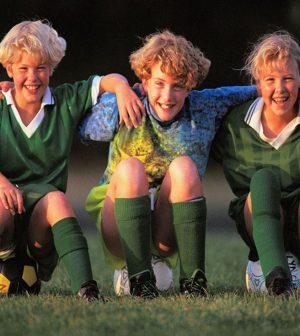- Understanding the Connection Between Anxiety and Depression
- How Daily Prunes Can Influence Cholesterol and Inflammation
- When to Take B12 for Better Absorption and Energy
- Epsom Salts: Health Benefits and Uses
- See What Saffron Can Do for Sleep and Heart Health
- 6 Common Mistakes to Avoid Before Your Physical
- Can Sweating Really Help You Beat a Cold?
- Strengthening Your Relationship: Practical Strategies
- Skip Storing This Everyday Product in the Fridge Door
- Green Tea + B3 Pairing May Boost Brain Health
When Are Head Injury Risks Highest for Young Soccer Players?

Young soccer players have more head impacts during practices but experience more severe head impacts during games, a small, preliminary study shows.
The findings could help devise ways to improve head impact safety in youth soccer, according to the researchers.
“Headers are a fundamental component to the sport of soccer. Therefore, it is important to understand differences in header frequency and magnitude across practice and game settings,” said study author Jillian Urban, from Wake Forest School of Medicine in Winston-Salem, N.C.
“Practices are more amenable to change than games. Therefore, understanding how we can restructure practice to reduce head impact exposure while teaching fundamental skills needed to safely play the sport is critical to improving head impact safety in the sport,” Urban explained in an American Academy of Neurology news release.
In the study, her team followed eight soccer players, ages 14 and 15, for two seasons. Each player wore a custom-fitted mouthpiece sensor during all practices and games, and the researchers used a time-synchronized camera to record all activities on the field and pinpoint head impacts.
The study authors tracked impacts per player per hour (impact rate) and the amount of time the soccer players did specific types of activities during practices and games. Depending on the activity, head impact rates ranged from 0.5 per player hour to 13.7 per player hour.
Technical drills such as heading the ball, practicing ball control and dribbling were associated with an average impact rate of 13.7 head impacts per player hour. Team interaction activities such as small-sided games in practice were associated with an average rate of 0.5 head impacts per player per hour, while there were 1.3 head impacts per player hour during games.
The researchers also examined average rotational head motion, measured in radians per second squared (rad/s2). Higher numbers signified more severe head impacts. Technical training was associated with an average magnitude of 550 rad/s2, while team interaction was associated with an average of 910 rad/s2 and games were associated with an average of 1,490 rad/s2.
The findings will be presented at the American Academy of Neurology’s Sports Concussion Conference, July 30-31. Such research is considered preliminary until published in a peer-reviewed journal.
“If the goal is to reduce the number of head impacts a young soccer player may get on the field, our findings suggest the best way may be to target technical training drills and how they are distributed within a season,” said Urban. “However, if the goal is to reduce the likelihood of players sustaining head impacts of greater magnitude, then the best bet may be to look at factors associated with high-magnitude head impacts that can occur during scrimmages and games.”
More information
The American Academy of Pediatrics has more on soccer injuries and safety.
SOURCE: American Academy of Neurology, news release, July 23, 2021
Source: HealthDay
Copyright © 2026 HealthDay. All rights reserved.










